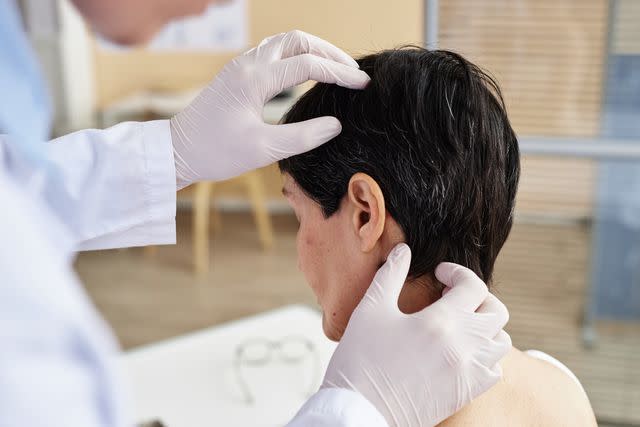Scalp Folliculitis: Treatment for Inflamed Bumps
Medically reviewed by Susan Bard, MD
Scalp folliculitis is a skin condition that affects the hair follicles on the scalp. It causes inflammation within the follicle creating a bump that can be found anywhere on the scalp or hairline. Treatment will vary based on the underlying cause.
This article will discuss the causes and symptoms of scalp folliculitis. It will also cover treatments for each specific cause.

SeventyFour / Getty Images
Treatment for Inflamed Scalp Folliculitis
A healthcare provider should examine any form of scalp folliculitis to determine the underlying cause. Because treatments are based on the underlying cause, getting the correct diagnosis is imperative to proper treatment. Below are scalp folliculitis causes and treatments for each cause.
Bacteria
When scalp folliculitis is caused by staph or another type of bacteria it may resolve without treatment. However, some people may need antibiotic treatment to resolve symptoms. It can be a topical antibiotic applied to the affected area or an oral antibiotic.
Fungal
If the underlying cause of scalp folliculitis is pityrosporum, then an oral antifungal is the best treatment. Occasionally, a topical antifungal can be used. However, the topical cream does not penetrate deep into the hair follicles and may not completely clear the infection.
Using a dandruff shampoo that has an antifungal like ketoconazole or ciclopirox can also help manage symptoms.
Viral
Treatment for viral causes of folliculitis will vary based on the virus type. People with a herpes infection will be treated with antivirals like acyclovir, valacyclovir, or famciclovir. Those with molluscum infections can be treated with cryotherapy.
Mites
Though it sounds unpleasant, 80% to 90% of people have mites on their skin. When mites cause folliculitis the first treatment is typically a topical permethrin cream. Other treatments include oral ivermectin and oral metronidazole, used alone or together.
Managing Recurring Scalp Folliculitis After Remission
Recurring scalp folliculitis will need to be treated by a healthcare provider. With so many different causes and variations of scalp folliculitis, managing the condition at home without professional help can lead to further problems.
Contact a dermatologist, a type of healthcare provider who specializes in skin conditions. They will be best prepared to develop a treatment plan suited for someone with recurrent scalp folliculitis.
Treatment and Other Options for Permanent Scalp Changes
If you have severe scalp folliculitis that's resistant to treatment, you may experience hair loss and scalp changes.
Treatment for severe folliculitis can include oral isotretinoin, antibiotics, or steroids.
It's normal for someone to be concerned about their appearance if there are changes to the skin on their scalp or if there is hair loss. A head cover like a hat, scarf, or wig can cover the scalp while the hair grows back.
Causes: Why Does Scalp Folliculitis Break Out?
Scalp folliculitis is caused by inflammation within the hair follicle. What causes the inflammation is not always known, but the most common cause is a bacterial infection of Staphylococcus aureus. Other causes of scalp folliculitis include:
Pityrosporum folliculitis: A fungal infection caused by Malassezia fungi
Gram-negative bacterial folliculitis: Also known as the hot tub folliculitis and is caused by gram-negative bacteria like Pseudomonas aeruginosa
Viral folliculitis: Typically caused by the herpes virus but can also be caused by Molluscum contagiosum
Demodex folliculitis: Caused by a mite commonly found on the skin
Eosinophilic folliculitis: A rare form of folliculitis caused by inflammation or an underlying infection in those with a weakened immune system
Scalp folliculitis can also be caused by inflammation due to ingrown hairs or certain medications.
Other Conditions Similar to Scalp Folliculitis
Several conditions cause symptoms similar to scalp folliculitis. Other conditions that may be confused for scalp folliculitis include:
Rosacea
How to Tell If You Have Scalp Folliculitis Symptoms
Scalp folliculitis may appear as small, red bumps along the hairline or on the scalp. These bumps can be papules (inflamed bump that does not appear to be filled with pus) or a pustule (inflamed bump that does appear to be filled with pus).
The affected area may be itchy and painful, leading to scratching and soreness. Other symptoms that can indicate someone has scalp folliculitis include:
Scalp sores
Bumps that drain pus
Yellow-brown scabs
Scalp Symptoms Not Getting Better
Scalp folliculitis symptoms can usually be treated at home. However, if symptoms are not getting better or worsening, then it is time to contact a healthcare provider. The provider will be able to definitively diagnose the folliculitis cause and determine the best course of treatment.
Prescription medications like antibiotics may be needed and might be the only way to improve symptoms.
Summary
Scalp folliculitis is a skin condition that affects the skin on the head. It causes bumps that can be red, pus-filled, and sore. Only a few bumps can be found on the head or several covering the scalp. Scalp folliculitis has many causes, including viruses and bacteria. Treatment aims to manage the underlying condition and care for the skin while it heals.
Read the original article on Verywell Health.

